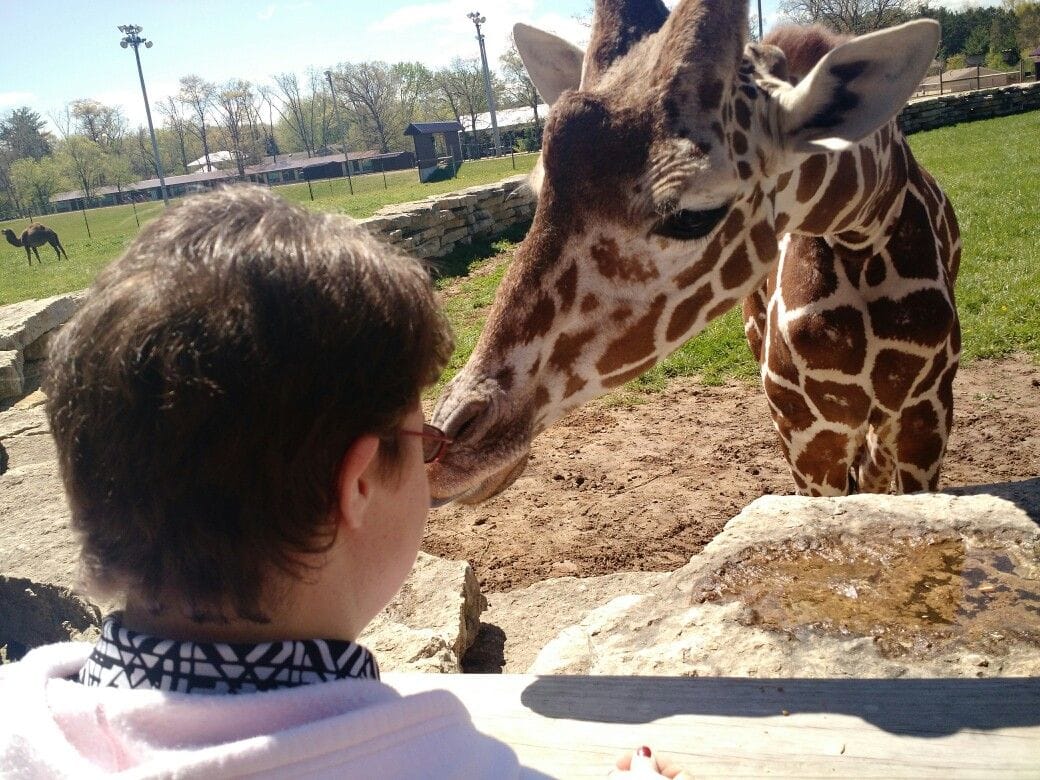Have you ever seen photos of giraffes with unusually short necks and wondered, “Do giraffes get Down syndrome?” The internet is full of mislabeled images, leading to confusion about this complex topic. While some giraffes may have conditions that visually resemble Down syndrome in humans, it’s essential to understand the critical differences. Let’s explore the fascinating world of genetics and separate fact from fiction.
Do Animals Get Down Syndrome? Unveiling the Truth Behind the Myths
You might have stumbled across pictures of giraffes with unusually short necks labeled as “Down syndrome giraffes.” It’s understandable why people might make that connection—these giraffes share some physical characteristics with humans with Down syndrome. However, giraffes can’t actually have Down syndrome.
Down syndrome is a genetic condition specific to humans, caused by an extra copy of chromosome 21. This extra chromosome leads to a variety of developmental differences. Animals, including giraffes, have different chromosome numbers and arrangements than humans. They can’t have trisomy 21 in the same way humans can.
So, what’s the explanation for those giraffes with unique features? They likely have a condition called skeletal dysplasia. Just like in humans, skeletal dysplasia in animals affects bone growth and development. This can result in shorter limbs, spinal curvature, and distinct facial features.
Think of it this way: while skeletal dysplasia in giraffes and Down syndrome in humans both impact physical development, their root causes are entirely different. Labeling a giraffe as having Down syndrome is not only inaccurate but also risks downplaying the experiences of people living with Down syndrome.
Why Accurate Terminology Matters
Using precise language when discussing genetic conditions—in both humans and animals—is vital for several reasons:
- Promotes Scientific Understanding: Accurate terminology reflects a deeper understanding of the underlying causes and mechanisms of genetic conditions.
- Encourages Respect and Sensitivity: Equating a human genetic condition with a visually similar animal condition can be hurtful and disrespectful to individuals with Down syndrome and their families.
- Supports Effective Communication: Clear and accurate language ensures that researchers, medical professionals, and the public can communicate effectively about these complex topics.
Can Any Animal Have Down Syndrome?
The short answer is no. Down syndrome, as we know it, is exclusive to humans. This is because Down syndrome arises from an extra copy of chromosome 21—a condition called “trisomy 21.” Animals have different chromosome numbers and arrangements than humans, making trisomy 21 impossible in other species.
While animals can’t have Down syndrome, they can experience a variety of genetic disorders that might share some similarities in terms of physical or developmental characteristics. Some examples include:
-
Skeletal Dysplasia: As mentioned with the giraffes, skeletal dysplasia encompasses a range of genetic disorders impacting bone growth and development. If you’ve ever wondered what a deep sea wolf eel looks like, you’re in for a treat. These creatures, found in the deepest parts of the ocean, exhibit skeletal dysplasia.
-
Birth Asphyxia: This occurs when an animal doesn’t receive enough oxygen during birth. It can lead to developmental challenges that might resemble some aspects of Down syndrome.
-
Metabolic Disorders: These disorders affect an animal’s metabolism—how their body processes energy. Have you ever heard of a deer with fangs? These deer, found in North American forests, can sometimes have metabolic disorders that affect their development.
Studying these genetic variations in animals is incredibly important. It provides valuable insights into developmental biology, which can ultimately enhance our understanding of human genetic disorders.
Analyzing Down Syndrome Prevalence and Addressing Racial Disparities
The internet often fuels misconceptions, and one common question is, “What race is Down syndrome most common in?”. This question itself reflects a misunderstanding of the condition. Down syndrome is not racially or ethnically biased. Let’s break down why:
- Down syndrome is a genetic condition: It’s caused by an extra copy of chromosome 21 (trisomy 21), which occurs randomly during cell division.
- Random Occurrence: The chances of a baby being born with Down syndrome are not influenced by the parents’ race or ethnicity.
While Down syndrome itself doesn’t discriminate, concerning disparities exist in healthcare and outcomes.
- Infant Mortality: Sadly, research suggests that Black infants with Down syndrome in the US have a lower first-year survival rate compared to white infants with Down syndrome.
- Systemic Factors: These disparities tragically highlight the urgent need to address systemic inequities in healthcare access, quality of care, and the pervasive influence of socioeconomic factors.
Analyzing the Average IQ of a Person with Down Syndrome:
Another common question is, “What is the average IQ of a Down syndrome person?”. While research suggests an average IQ score of around 50 for individuals with Down syndrome, it’s crucial to approach this information with careful consideration:
- IQ is a Limited Measure: IQ tests, while valuable, only measure certain cognitive abilities. They don’t capture the full spectrum of intelligence, especially for individuals with Down syndrome.
- Diverse Abilities: People with Down syndrome, like all individuals, have unique strengths and challenges. Some excel in social situations, artistic expression, or possess a remarkable capacity for empathy.
Here’s what’s important to remember:
- Focusing on Potential: Instead of fixating on IQ scores, let’s prioritize understanding and appreciating the individual strengths and talents of people with Down syndrome.
- Early Intervention is Key: Early intervention programs can significantly impact cognitive development and adaptive skills in individuals with Down syndrome.
It’s also important to be aware of other animals with genetic conditions that might visually resemble Down syndrome:
-
Down Syndrome Lion: The down syndrome lion is a rare and beautiful creature. These lions are born with a genetic condition that gives them a distinctive appearance.
-
Eel Wolf: The eel wolf is a fascinating creature that lives in the deep sea. These creatures have a long, slender body and a large head, and are another example of unique genetic expressions in the animal kingdom.
Understanding the complexities of genetics and approaching discussions about genetic conditions with sensitivity is crucial. Let’s strive to use accurate language, challenge misconceptions, and celebrate the incredible diversity of life—in both humans and animals.
- Unveiling the Enigma: Mansoureh Khojasteh Bagherzadeh’s Public Appearances & Private Life in Iran - July 18, 2025
- Unveiling the Mystery: Mansoureh Khojasteh Bagherzadeh’s Husband: A Rare Glimpse into a Private Life - July 18, 2025
- Unveiling Masoud Khamenei’s Mother: Power, Influence, and Iran’s Future - July 18, 2025
















